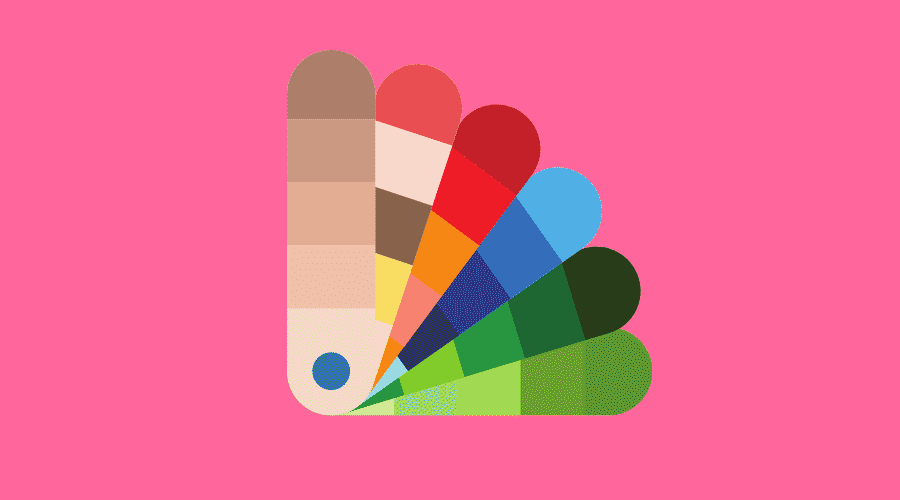
How to Identify the Right Color Scheme for Your Brand & Website
Posted Feb 9, 2022 | Updated 4 years ago
Choosing a color scheme is an important part of the brand development process for any company.
The colors you select can, quite literally, set the tone for your business. They communicate a message and evoke emotions in prospective and existing customers that can even motivate them to take certain actions.
There are no wrong branding colors necessarily, but they are a tool you have at your disposal. As such, this isn’t a throw-away decision. It’s important to be deliberate and thoughtful to identify what you want to communicate to your customers, what you want them to feel, and what colors can fulfill that purpose.
What is the Process for Choosing Branding Colors?
Thinking of the large brands that you love, it’s easy to identify which ones have successfully created an association between a particular color, or colors, and their brand. Take Starbucks, for instance. Their specific shade of green is recognizable, even without a logo. Netflix, Instagram, Twitter and Google have also used color branding effectively. Even if you’re operating a smaller business, you can make a significant impression on your customer base with the right color scheme.
While you could theoretically choose whichever colors appeal to you personally, it’s helpful to think of the industry in which you work, your business culture and personality, and how you’ll be using the colors.
In general, most brands choose between three to four colors for their color scheme. This will include the base, which should align with your business’ main personality trait, or the one that’s most important, as well as what will appeal to your target audience.
Next, your accent color(s) should highlight secondary personality traits. However, these colors also need to complement your base color.
Finally, you’ll want to choose a neutral that can serve as your background or when you want a more subtle representation of your brand. Together, these various colors should provide a holistic visual description of your brand.
On the other hand, you may decide to choose only one or two colors. Regardless, you’ll need specific hues, which means having an exact RGB or CMYK formula that can be used for all subsequent graphic design.
Graphic Design Color Palette Ideas for Businesses
While your personal taste may play a part in your decision-making process, it’s best to rely primarily on color theory to capture an objective representation of your distinctive brand personality. This starts by knowing what colors stimulate what emotions. Here are a few examples from various industries:
1. Luxury Brand
In the modern age, luxury is often associated with sleek minimalism. Often, high-end brands—such as boutique shops, opulent spas or classy tech firms—will utilize a monochromatic color scheme or a single distinctive color paired with a neutral, like gray or black.
Monochromatic color palettes are those that utilize a single basic hue that is depicted in different tones (the color with added gray), tints (the color with added white), and shades (the color with added black). This creates a very clean, minimalistic and sophisticated palette. Red, purple and black are good options for a luxury brand, depending on your particular industry.
2. Professional Services
For professional services, you want to present your brand as trustworthy, high-caliber and no-nonsense. Whether you run an accounting or consulting firm or another small business in a similar sector, blues and grays are a good option. Dark blue, in particular, evokes security, formality, trustworthiness and professionalism. Light blues have a similar effect, but with less of a mature aura. As a neutral, gray is a classic and subdued color that is suitable for a range of industries and businesses.
3. Fun or Family Friendly Business
If you run an art store, hair salon, novelty shop, family friendly restaurant or other welcoming and community-minded business, you can afford to be a bit more whimsical and fun-loving. In fact, that’s exactly the kind of atmosphere you want to promote with your color scheme. Yellow is often perceived as cheery, optimistic and inviting. It’s also associated with affordability. Pinks and purples signify youth and creativity, and they can range from playful and quirky to luxurious, depending on the hue. Orange also evokes friendliness and vitality, whereas browns often stand for down-to-earth, earthy and rugged traits.
4. Landscaping Design Company
The most obvious choices for a landscaping design company are greens and blues. Green signifies growth, stability and a connection to the natural world. That’s fitting for a company in this industry, whether you are a landscape architecture firm, a design-build business, or a full-service agency. However, if you go with blues or greens, consider a monochromatic color scheme to highlight your brand’s sophistication and professionalism.
5. Personal Brand
With a personal brand, you have more freedom when choosing your color palette, but that can also make the process more difficult. There are fewer industry standards to use as inspiration. When developing a personal brand, a good rule of thumb is to take a look at your closet. What colors do you see? The ones that stand out are most likely a good representation of your personality and taste and, thus, a good start for your personal brand.
Best Practices for Using Branding Colors
In addition to considering color theory and what colors are associated with what emotions, you should also take into account how your color scheme will be used for marketing and advertising your brand. Here are a few extra things to think about when developing your professional color palette:
- How the colors will appear on your company website and other digital platforms?
- What colors will look good on your professional print materials?
- If the colors will appear right when using a basic printer at your home or office?
- How your colors will print in black-and-white, or greyscale, defaults?
- Whether the colors will show up well when printed on swag, or physical items like shirts and mugs, and how much it will cost? (i.e. the more colors, the higher the cost).
Selecting Colors During the Brand Development Process
Choosing the appropriate color scheme for your small business is easier said than done. Fortunately, it typically takes place as part of a larger branding process, during which you’ll identify your brand personality and target audience. If you aren’t sure where to start, let our team at Third Angle help. We can provide valuable insights as you develop your brand and help with various tasks, from creating your logo and website to putting together other print and digital marketing campaigns.

